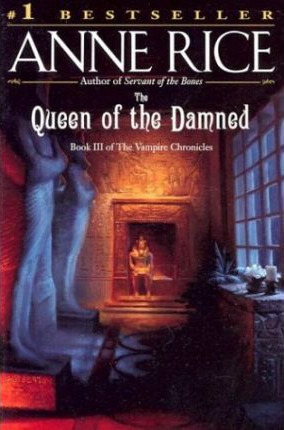- The Good: Dark, gothic drama spanning millennia
- The Bad: Mustache twirling villain; too plot-heavy in a story with incredible characters
- The Literary: Surprisingly historical
The adventures of vampire Lestat de Lioncourt continue immediately following the cliffhanger the ending of The Vampire Lestat in the third book of the Vampire Chronicles series. The mysterious origins and history of the first vampires is revealed, featuring a pre-Egyptian Queen and twin-sister witches in ancient Assyria.
First, the Vampire Chronicles continue to be a lot of fun for me. The first two books in the series are gothic and dramatic, historic and philosophical, with captivating characters who don’t need much plot to keep you reading. In Queen of the Damned, Rice makes many bold choices. First and foremost, she provides an answer to vampire origins, effectively answering a mystery that her characters could have dwelt on for many more books, if not forever.
Second, Rice introduces an extraordinary number of new POV characters. In fact, most of this book isn’t told by Lestat. Part One features Armand, Marius, Louis, Gabrielle, Daniel Molloy—the boy reporter of Interview with the Vampire—and Jesse Reeves, a young human woman with supernatural tendencies. A few threads unite each story, including Lestat’s upcoming rock concert in San Francisco, the same tragic dream about red-haired green-eyed twin-sisters that both vampires and many humans seem to share, and the fact that vampires around the world are spontaneously combusting.
We soon learn that Akasha, Queen of Vampires, Queen of the Damned, the One Who Must Be Kept, from The Vampire Lestat is now awake, thanks to Lestat’s rock music. She takes Lestat as her consort and has a plan to save mankind from itself by remaking the world as she sees fit. Rice offers the history of the vampires throughout, in between the stories of characters and the plot to try to Akasha from destroying the world as we know it.
Though I love Lestat, I’m perfectly content reading about any other character that Rice writes. What fails for me is the reliance on plot in this installment. This is the third bold move for Rice. Though the plot is quite good, it’s big and complicated, and also bulky. What shines in these books are the moral quandaries, the need for companionship across centuries, and the search for meaning and identity even when you identify as inherently evil. Akasha is too evil, too power hungry, and as a reader, you’re not at all conflicted about whether or not she should die, so the emotional stakes are low (except for Lestat, who loves Akasha).
On the other hand, with Akasha and the twins, Rice manages to capture the huge span of time across the ages incredibly well. I wonder how the next books will feel now that Lestat and Armand seem like children.
Highly recommended for fans of vampires, though Interview and Lestat are still my favorites.
“It was haunted; but real hauntings have nothing to do with ghosts finally; they have to do with the menace of memory.”
